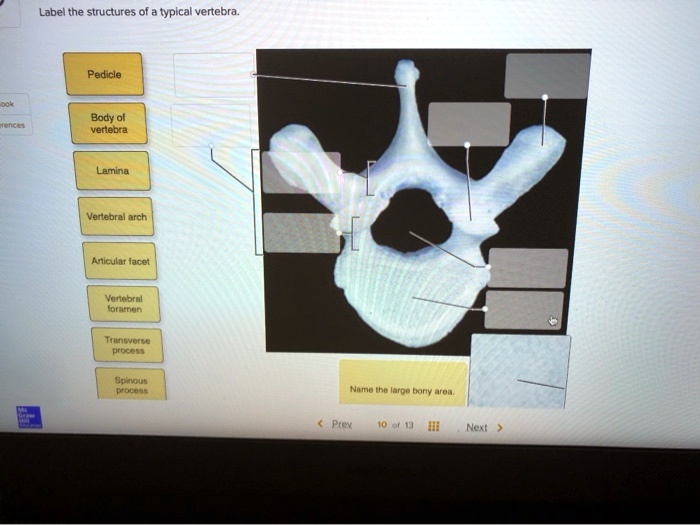Label the structures of a typical vertebra, the fundamental building blocks of our spine, and delve into the intricate architecture that supports and protects our delicate nervous system. This journey will illuminate the remarkable design of the human body, showcasing the harmonious interplay of bone, cartilage, and ligaments that orchestrate our every movement.
Vertebrae, the individual segments that constitute the spinal column, exhibit remarkable variations in shape and size, reflecting their diverse roles in different regions of the spine. From the weight-bearing robustness of the lumbar vertebrae to the delicate mobility of the cervical vertebrae, each vertebra is a masterpiece of evolutionary engineering.
Structures of a Typical Vertebra: Label The Structures Of A Typical Vertebra

Vertebrae are the individual bones that make up the vertebral column, also known as the spine. They provide support, protection, and mobility to the body. Each vertebra consists of several components that work together to form a complex and functional structure.
Vertebral Body
The vertebral body is the large, anterior portion of the vertebra. It is shaped like a cylinder or box and is responsible for weight-bearing. The size and shape of the vertebral body vary depending on the region of the spine.
For example, the vertebral bodies in the lumbar region are larger and more robust than those in the cervical region.
Vertebral Arch
The vertebral arch is a bony ring that extends posteriorly from the vertebral body. It consists of two pedicles, two laminae, a spinous process, and two transverse processes. The pedicles connect the vertebral body to the laminae, which form the roof of the vertebral arch.
The spinous process projects posteriorly from the junction of the laminae, while the transverse processes project laterally.
Vertebral Canal
The vertebral arch encloses the vertebral foramen, which forms the vertebral canal. The vertebral canal runs through the entire length of the vertebral column and contains the spinal cord, nerve roots, and meninges. The vertebral canal protects the delicate structures within it from injury.
Intervertebral Disc
Intervertebral discs are located between adjacent vertebrae. They consist of a tough outer layer called the annulus fibrosus and a soft, gelatinous inner core called the nucleus pulposus. Intervertebral discs provide shock absorption, flexibility, and allow for spinal movement.
Facet Joints
Facet joints are synovial joints that connect adjacent vertebrae. They are located between the superior and inferior articular processes of the vertebrae. Facet joints allow for limited spinal movement and help to prevent excessive motion that could damage the spinal cord.
Vertebral Foramina
Vertebral foramina are small openings on the lateral sides of the vertebral arch. They allow for the passage of spinal nerves and blood vessels. The vertebral foramina protect the spinal nerves as they exit the vertebral canal.
Spinous Process, Label the structures of a typical vertebra
The spinous process is a bony projection that extends posteriorly from the junction of the laminae. It provides attachment points for muscles and ligaments. The spinous process is also used as a landmark for spinal anesthesia.
Transverse Processes
The transverse processes are bony projections that extend laterally from the vertebral arch. They provide attachment points for muscles and ligaments. In the thoracic region, the transverse processes articulate with the ribs.
General Inquiries
What is the function of the vertebral body?
The vertebral body bears the weight of the upper body and transmits forces along the spine.
What is the vertebral arch composed of?
The vertebral arch is formed by the pedicles, laminae, spinous process, and transverse processes.
What is the role of the intervertebral disc?
The intervertebral disc provides cushioning between vertebrae, absorbs shock, and facilitates spinal movement.
What type of joint is formed by the facet joints?
The facet joints are synovial joints that allow for limited gliding movements between vertebrae.

